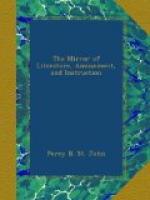With fiendlike power, thou dragg’st him back with thee,
Point’st to some scene of early guilt and woe,
Opening the source from whence his sorrows flow.
As round the bark which feels the tempest’s shock,
The lightning plays, and shows the fatal rock,
So memory brings our sorrows all to light
With vivid truth presents them to the sight;
Pursues the wretch who else some joy might find,
To fix her seat of empire in his mind.
As desert lakes in sad illusion fly,
Before the weary traveller’s cheated eye
So memory shows, those hopes we still would cherish.
Pleased but to fade, allured us but to perish.
M.B.S.
* * * * *
SPIRIT OF THE PUBLIC JOURNALS.
* * * * *
ON COALHEAVERS.
Although in this age of all but universal hypocrisy and make-believe, every man has at least two fashions of one countenance, it is in dress principally that most men are most unlike themselves. But the coalheaver always sticks close to the attire of his station; he alone wears the consistent and befitting garb of his forefathers; he alone has not discarded “the napless vesture of humility,” to follow the always expensive, and often absurd fashions of his superiors. All ungalled of him is each courtier’s heel or great man’s kibe. Yet, is not even his every-day clothing unseemly, or his aspect unprepossessing. He casts as broad and proper a shadow in the sun as any other man. Black he is, indeed, but comely, like the daughters of Jerusalem.—To begin with the hat which he has honoured with a preference—what are your operas or your fire-shovels beside it? they must instantly (on a fair comparison) sink many degrees below zero in the scale of contempt. In a word, I would make bold to assert that it unites in perfection the two grand requisites of a head covering, beauty and comfort. Gentlemen may smile at this if they will, and take exception to my taste; but, I ask, does the modern round hat, whatever the insignificant variations of its form, possess either quality? No, not a jot of it. One would think, by our pertinacious adherence to the head-ach giving, circular conformation, that we wished to show our anger at the Almighty for not shaping our caputs like cylinders. In fine, though the parson’s and the quaker’s hat has each its several merits, commend me to the fan-tailed shallow. The flap part attached to the cap seems, at first sight, as to use, supernecessary, although so ornamental withal. It no doubt (as its name, indeed indicates) had its origin in gallantry, and was invented in the age of fans, for the purpose of cooling their mistresses’ bosoms, heated—as they would necessarily be—at fair time, by their gravel-grinding walks, under a fervid sun, to the elegant revels of West-end, of Greenwich, or




